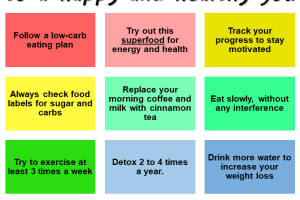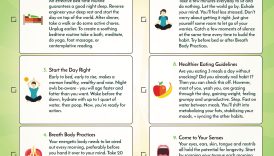The Elite’s Guide to Optimal Living: Health Tips and Tricks

Introduction to Optimal Living
Understanding the Concept of Optimal Living
Optimal living is not merely about existing; it’s about thriving in all aspects of life. It encompasses a holistic approach to well-being, combining physical health, mental wellness, and emotional stability. The aim is to harmonize these elements to enhance overall quality of life. Living optimally means making conscientious choices that promote a balanced lifestyle. For example, Jane, a working mother, found herself constantly exhausted and overwhelmed. By integrating simple practices like meal prepping and family exercise nights, she transformed her chaotic lifestyle into a structured routine promoting happier family interactions and better health.
- The Elite’s Guide to Optimal Living: Health Tips and Tricks
- Introduction to Optimal Living
- Understanding the Concept of Optimal Living
- Benefits of Prioritizing Health and Well-being
- Nutrition and Diet Tips
- Importance of Balanced Nutrition
- Superfoods for Optimal Health
- Exercise and Fitness Strategies
- Types of Exercises for Overall Fitness
- Creating a Sustainable Fitness Routine
- Mental Health and Wellness
- Managing Stress for Improved Well-being
- Practicing Mindfulness and Meditation Techniques
- Quality Sleep Habits
- Importance of Adequate Sleep for Health
- Tips for Improving Sleep Quality
- Hydration and Its Impact on Health
- Benefits of Staying Hydrated
- Ways to Ensure Proper Hydration
- Balancing Work and Personal Life
- Setting Boundaries for Work-life Balance
- Incorporating Self-care Practices into Daily Routine
Benefits of Prioritizing Health and Well-being
Prioritizing health and well-being leads to a myriad of benefits, including:
- Increased Energy Levels: Feeling energized can transform daily activities into enjoyable experiences.
- Enhanced Mood: Good health often translates into improved mental state and resilience against stress.
- Improved Productivity: Optimal living fosters a sharp mind, allowing for better focus and efficiency at work.
- Stronger Relationships: A healthier individual is likely to engage more deeply in relationships, improving connection and satisfaction.
By focusing on overall well-being, individuals like Jane not only uplift their own lives but also create a positive ripple effect, enhancing the lives of those around them. Prioritizing health is truly an investment in a brighter, more fulfilling future.
Nutrition and Diet Tips
Importance of Balanced Nutrition
Transitioning towards optimal living involves a focus on nutrition, particularly the importance of balanced meals. A well-rounded diet is crucial because it provides the body with the necessary nutrients to function effectively and maintain energy throughout the day. Consider Mark, who faced constant fatigue due to poor eating habits. After seeking advice, he learned the fundamentals of balanced nutrition. Emphasizing a mix of carbohydrates, proteins, and healthy fats in his meals made a remarkable difference. Mark’s experience highlights that simple changes, like incorporating whole grains and fresh vegetables, can enhance vitality and overall well-being.
Superfoods for Optimal Health
In the pursuit of better health, integrating superfoods into one’s diet can be tremendously beneficial. Superfoods are nutrient-rich foods that offer an array of health benefits. Here are some noteworthy options:
- Quinoa: A complete protein source, great for muscle repair.
- Berries: Packed with antioxidants, beneficial for heart health.
- Kale: A leafy green loaded with vitamins A, C, and K.
- Chia Seeds: High in omega-3 fatty acids, promoting brain health and reducing inflammation.
By intentionally including these superfoods in daily meals, individuals can effectively boost their nutrition. For instance, starting the day with a smoothie enriched with spinach, bananas, and chia seeds can elevate energy levels and optimize health. Prioritizing balanced nutrition and incorporating superfoods leads not only to physical benefits but also nurtures the mind, contributing to a vibrant life.
Exercise and Fitness Strategies
Types of Exercises for Overall Fitness
With a strong foundation in nutrition, the next step towards optimal living lies in incorporating regular exercise. Understanding the various types of exercises can enhance one’s overall fitness. There are three main categories to consider:
- Cardiovascular Exercises: These include activities such as running, cycling, or swimming, which boost heart health and stamina.
- Strength Training: Engaging in resistance exercises, like weightlifting or body-weight workouts, helps build muscle and improve metabolism.
- Flexibility and Balance: Practices such as yoga or Pilates enhance flexibility while promoting relaxation and mindfulness.
Take Sarah, who started her fitness journey with a mix of jogging, circuit training, and yoga. This varied routine not only kept her engaged but also helped improve her physical strength and mental clarity.
Creating a Sustainable Fitness Routine
To make the most of these exercises, it’s crucial to create a sustainable fitness routine that fits individual lifestyles. Here are some tips:
- Set Realistic Goals: Start with achievable objectives to avoid burnout.
- Schedule Regular Workouts: Treat exercise like an essential appointment in your calendar.
- Mix It Up: Keep workouts diverse to prevent boredom and work different muscle groups.
- Listen to Your Body: Rest when necessary and don’t push too hard.
By adopting this approach, individuals can cultivate a consistent fitness habit like Sarah, who gradually found joy in her daily workouts. A sustainable routine not only supports physical health but also enriches mental and emotional well-being, paving the way for a fulfilling life.
Mental Health and Wellness
Managing Stress for Improved Well-being
As individuals progress on their journey of optimal living, it’s essential to address mental health alongside physical fitness. One of the most significant contributors to mental distress is stress. Effectively managing stress is crucial for overall well-being, as prolonged stress can lead to a myriad of health issues, including anxiety and hyper tension. One practical method to manage stress is identifying its sources. For instance, Emily, a busy entrepreneur, felt overwhelmed by her workload. By acknowledging her triggers and incorporating daily breaks, she successfully reduced her stress levels. Here are some effective strategies for stress management:
- Time Management: Prioritize tasks and set realistic limits on each day.
- Physical Activity: Engage in regular exercise to release endorphins that combat stress.
- Social Support: Lean on friends or family for support during challenging times.
Practicing Mindfulness and Meditation Techniques
In addition to managing stress, practicing mindfulness and meditation can greatly enhance mental wellness. These techniques cultivate a sense of presence and calm. Consider the story of Alex, who started meditating for just five minutes a day. Over time, he found that this practice improved his focus and emotional resilience. To get started with mindfulness, try these techniques:
- Breathing Exercises: Take deep breaths, focusing solely on the sensation of your breath entering and leaving your body.
- Guided Meditation: Use apps or online resources for guided sessions that teach meditation fundamentals.
- Mindful Walking: Engage in walking with awareness of each step.
By incorporating stress management and mindfulness practices into their routine, individuals can significantly enhance their mental health, leading to a balanced and fulfilled life.
Quality Sleep Habits
Importance of Adequate Sleep for Health
In the pursuit of optimal living, one vital aspect that often gets overlooked is the role of quality sleep. Adequate sleep is essential for both physical and mental health. It allows the body to recover, supports brain function, and regulates mood. Take Laura, for instance. She initially underestimated the power of sleep; frequently staying up late to finish work. However, after experiencing increased fatigue and irritability, she prioritized her sleep and noticed a significant improvement in her overall well-being. Research shows that adults generally need 7-9 hours of sleep per night to function optimally. Insufficient sleep can lead to:
- Impaired cognitive function
- Weakened immune responses
- Increased stress levels
Tips for Improving Sleep Quality
To enhance sleep quality, consider implementing the following tips:
- Establish a Sleep Routine: Go to bed and wake up at the same time each day, even on weekends.
- Create a Relaxing Environment: Keep your bedroom dark, cool, and quiet. Consider blackout curtains or white noise machines.
- Limit Screen Time Before Bed: Reduce exposure to screens an hour before sleep to improve the chances of drifting off easily.
- Mind Your Diet: Avoid heavy meals, caffeine, and alcohol close to bedtime.
- Incorporate Relaxation Techniques: Meditation or gentle yoga can help signal your body that it’s time to wind down.
By prioritizing quality sleep, individuals like Laura can experience profound benefits, such as enhanced mood, improved focus, and increased energy levels, contributing to a truly optimal lifestyle.
Hydration and Its Impact on Health
Benefits of Staying Hydrated
Continuing the journey to optimal living, it’s crucial to address the often underrated aspect of hydration. Staying properly hydrated is vital to overall health and well-being. Water serves as the body’s essential lubricant, facilitating numerous functions. Consider Tom, who lived with chronic headaches and fatigue. After consulting with a health professional, he discovered that his hydration levels were far below what was necessary. Once he made a conscious effort to drink more water, he saw a remarkable improvement. Proper hydration offers numerous benefits, including:
- Enhanced Brain Function: Adequate hydration can improve focus, memory, and mood.
- Improved Digestion: Water aids in digestion and helps prevent constipation.
- Better Physical Performance: Staying hydrated can enhance endurance during exercise and speed up recovery.
- Healthy Skin: Proper hydration can improve skin elasticity and reduce dryness.
Ways to Ensure Proper Hydration
To ensure proper hydration, consider implementing these strategies:
- Carry a Water Bottle: Keep a reusable water bottle handy to remind yourself to drink throughout the day.
- Set Daily Goals: Aim for a specific amount of water each day, adjusting based on activity levels and climate.
- Infuse Your Water: Add fruits like lemon, cucumber, or mint to enhance flavor and encourage more frequent consumption.
- Eat Water-Rich Foods: Include plenty of fruits and vegetables, such as cucumbers, watermelon, and oranges, in your diet.
By prioritizing hydration, individuals like Tom can experience a multitude of health benefits, leading to increased vitality and support for their overall journey toward optimal living.
Balancing Work and Personal Life
Setting Boundaries for Work-life Balance
As we explore the various aspects of optimal living, it’s essential to delve into the delicate balance between work and personal life. A significant challenge many people face is setting boundaries that foster a healthy work-life balance. Without these boundaries, work can seep into personal time, leading to stress and burnout. Take John, for instance. As a remote worker, he struggled with disconnecting from tasks after hours. By implementing clear boundaries—like a designated workspace and fixed work hours—he reclaimed his evenings for family and relaxation. Here are some practical tips for setting boundaries:
- Communicate Your Availability: Let colleagues know your work hours to manage their expectations effectively.
- Create a Designated Workspace: Limit work to a specific area in your home to draw a line between work and personal spaces.
- Unplug After Hours: Designate a time to shut off work email and notifications to focus on personal activities.
Incorporating Self-care Practices into Daily Routine
In addition to setting boundaries, integrating self-care practices into your daily routine is vital. Self-care can take many forms and doesn’t have to be overly elaborate. For example, Lisa began to incorporate short breaks into her workday to stretch and breathe deeply. This simple act significantly improved her mood and focus. Here are some self-care ideas to consider:
- Mindful Breaks: Take five minutes every hour to get away from your desk for a brief walk or breathing exercises.
- Engage in Hobbies: Spend time doing what you love, whether it’s painting, reading, or gardening.
- Practice Gratitude: Keep a gratitude journal to acknowledge positive aspects of each day.
By setting boundaries and prioritizing self-care, individuals can create a harmonious balance between work and personal life, ultimately supporting their journey towards optimal living and holistic wellness.





